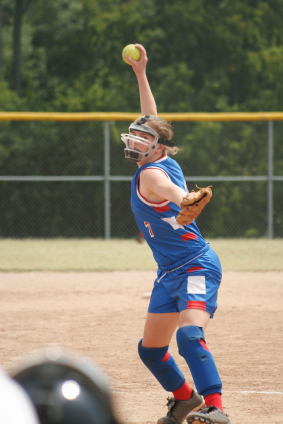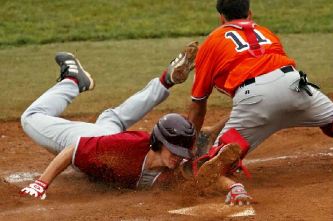There's more to safety equipment in baseball and softball these days than just batting helmets and catcher's gear. Here's a rundown of some of the other equipment that can - or, in some cases, should - be worn to reduce the injury risk:
- Polycarbonate plastic face guard, metal cage or polycarbonate full-face shields.

- Face guards and shields must meet the ASTM standard F910.
- Face guards covering the lower part of the face from the tip of the nose to below the chin protect the teeth and facial bones; make sure the space between the top of the guard and the brim of the helmet is less than the diameter of a baseball in order to indirectly protect the eyes without impairing vision.
- Despite resistance to their use by some players and league officials based on compromised visibility through a full-face shield over time, the AAP urges use based on studies demonstrating that they significantly reduce injury risk. The group notes that recent research among high school baseball athletes has led to a call for infielders and pitchers to wear face shields.
- Sports goggles should be mandatory for functionally one-eyed athletes (best corrected vision in the worse eye of less than 20/50), both while batting and in the field. The polycarbonate lenses should meet ASTM standard F803.
- Safety glasses/sunglasses: All athletes who wear glassess or sunglasses while playing baseball or softball should make sure that the lenses and frames meet appropriate safety standards in order to minimize the risk of breaking or shattering on contact with a softball or baseball;
- Padded sliding pants. Worn underneath baseball pants, the pants provide good
protection against contusions and abrasions to the hips and thigh when
athletes slide feet first into a base.

- Important note: Head-first sliding creates the risk of head injuries from collisions with the fielder or from being hit by a thrown ball; upper-extremity injuries can occur from the contact and deceleration forces that occur when the hands of a diving body encounter the stationary base. As a result, current Little League Baseball rules ban head-first sliding by a runner, except when retreating to a previously held base.
- Batting gloves not only improve grip on the bat but reduce the risk of blisters;
- Protective cups: Boys playing baseball or softball should always use a hard plastic athletic cup to protect the testicles. Although catchers, pitchers and infielders are at the greatest risk, testicular injuries can occur to any player, while in the field, batting or running the bases;
- Knee savers. Since their introduction, so-called "knee savers" (triangular-shaped foam pads which fit behind the knee) have enjoyed widespread popularity as a way of minimizing the strain on the knee joint while a catcher is in his crouch; and
- Elbow pads/shin guards: Some batters wear shin guards to protect the tibia (shin) against injury; protective elbow pads for batters have also gained notice.
Sources: American Academy of Pediatrics, Council on Sports Medicine and Fitness, Policy Statement: Baseball and Softball. Pediatrics. 2012;129(3):842-856. (doi: 10.1542/peds.2011-3593)(accessed February 26, 2012); Little League Playing Rules and Regulations. Rule 7.08(a)(4)
Posted March 16, 2012








